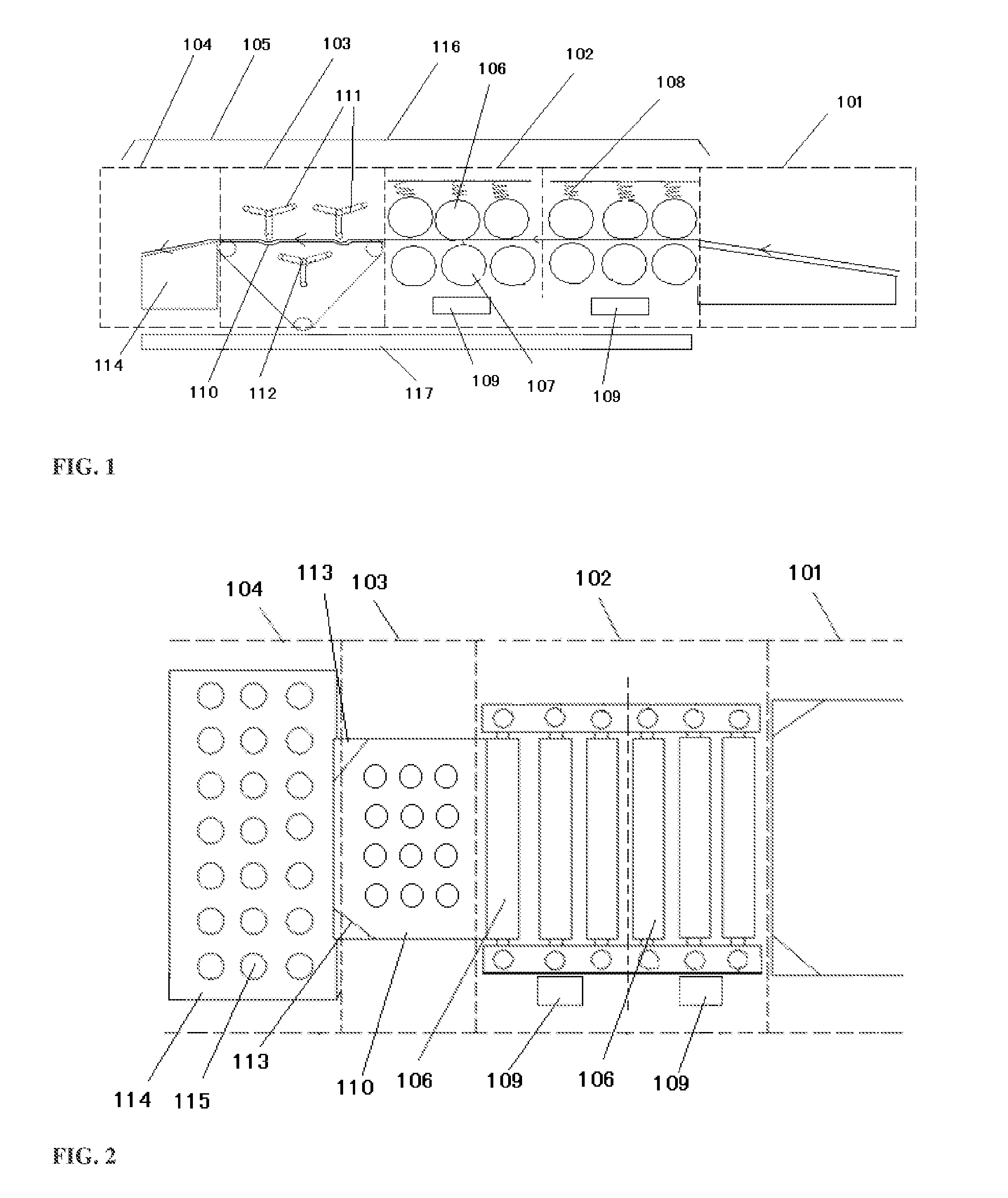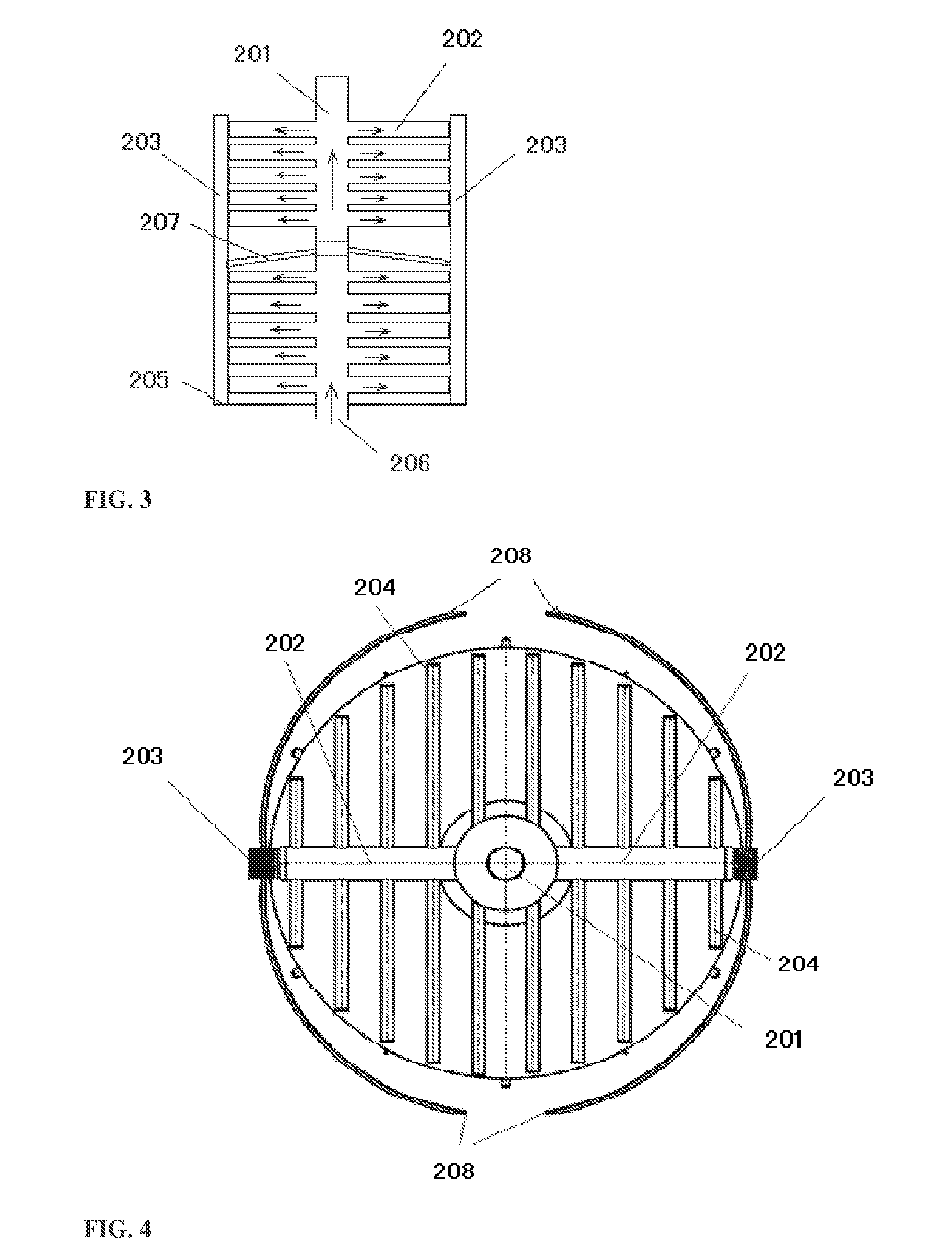[0023]The present disclosure has the following advantages by adopting the above technical solutions: 1) by means of the upper and lower rows of the rollers set in pairs, the bast fiber can be squeezed and rubbed repeatedly and degummed, so the use of
pollution-free physical and mechanical degumming can reduce the
biochemistry degumming difficulty and pressure, the processing time and the
pollutant discharge, and improve the fiber separation index and the
biochemistry degumming uniformity, at the same time, by-products from the mechanical degumming can also be collected to achieve the purpose of comprehensive utilization. In trials, mechanical degumming before digesting not only removed 5%-8% chunks of gum, but also removed impurities resulting from the uncompleted separation of hemp
skin and stem. Using this method, the bast separation index will increase by 10˜20%; 2) the biological degumming device of the present disclosure contains three groups of independent systems, wherein each
system includes a main cylinder designed with a
yarn hanging rack inside, and the bast fiber hung on the yarn hanging rack is treated by means of a treatment solution which is prepared within the main cylinder, therefore, the solution containing biological strains can be used many times, which on the one hand effectively reduces cost and improves the economic benefit, and on the other hand makes the
sewage easy to collect and process, thus reducing environmental
pollution greatly. The coiled
pipe is provided within the main cylinder, wherein the water in the coiled
pipe is provided by the hot water bucket, therefore, the treatment solution in the main cylinder is heated by the heat released by the hot water in the coiled
pipe, consequently, the
heating temperature is stable and has a high
controllability. After degumming, putting a certain scouring medium and lye into the main cylinder of the sterilizing
system, improving the temperature above 100° C., and keeping this heat for 10-30 min can achieve inactivating effects on the
bacteria, and also realize the first washing of the residual gum, so as to ensure that the
bacteria are prevented from being lost to the external environment and reduce the burden of
post treatment; 3) the high-temperature digesting device is disposed with a main cylinder having a main cylinder and a heating device disposed outside, wherein the treatment solution in the main cylinder can be circulated between the main pump and the main cylinder, at the same time, the circulating treatment solution can also be heated by the heating device, therefore, the temperature of treatment solution can be maintained within the setting range. The secondary cylinder, which can be used to supplement chemical additives or a
bleach agent to the main cylinder, is disposed on the main cylinder from outside, thus, it guarantees the requirements of the process within the main cylinder. The main pump is disposed outside the main cylinder within which the yarn hanging device is positioned, wherein the bast fiber is hung on the yarn hanging device, and thus the inventive device can achieve the purpose of spraying and circulating efficiently inside the cylinder, which makes the processing uniformity much higher than that of the traditional
liquid circulation processing device; 4) the yarn hanging rack used in each device is disposed with the hollow post, wherein at least one layer of hollow beam is disposed on two sides of the hollow post, and the hanging rod with a plurality of holes designed on the upper half part is disposed at the top of the hollow beam, and the spraying rods with holes designed on the side face are disposed below each layer of hollow beams. Consequently, when the main pump starts working, the treatment solution can be sprayed from each hanging rod hole to perform the spray processing on the bast fibers all around, and the bast fibers can be processed uniformly and thoroughly. A meshed
chassis is disposed on the hollow post bottom, thus it can make the treatment
solution flow into the yarn hanging device, and prevent the scattered fiber from falling into the cylinder containing the treatment solution, making the treatment solution circulating smoothly. A plurality of yarn hanging racks may be disposed in series to become one communicated body to circulate the treatment solution conveniently. The hanger is disposed on the top of the hollow post, as a consequence, the hanger may be moved into the treatment tank by a
lifting equipment even if they are used in series, the moving is also very convenient. When two yarn hanging racks are in series, there is a cover body disposed between them, so when the yarn hanging racks are used in series, the cover body can be used to prevent the water from leaking out of the upper yarn hanging rack, so that the water leaked from the upper hanging rack can be discharged from the water outlet of the outer cylinder, therefore, it can make the treatment effects of different series locations of the upper and lower yarn hanging racks the same; 5) the separating and washing device of the present disclosure is disposed with multi-group of separating and washing units, wherein each group of separating and washing units is disposed with a plurality of spaced beaters and separating rollers, wherein by
high pressure water washing, beater beating, gathering with the bundle collecting plate and
carding with the separating roller, the
hemp fiber is made to be more uniform, thus, the fiber separation index is better and the
spinning property is improved greatly. As a consequence, it can save water about three times than that of
conventional treatment; 6) the hemp-
softening oil applying device of the present disclosure is variable in speed to perform squeezing and
rubbing on the rollers, at the same time, applying hemp-
softening oil and washing and softening further improves the softening effect of degummed hemp, and then the
spinning property of
hemp fiber is improved greatly; 7) the stretch-breaking and carding device of the present disclosure combines the functions of straightening, stretching, breaking, collecting and carding together, and as a result, produces hemp strips for
spinning coarse yarn in one step which can shorten the process and reduce the cost, and only the high count yarn spinning process needs to perform carding; wherein through the controlling over the speed, the pressure and the interval of the stretch-breaking mechanism, the
hemp fiber strip with different lengths can be obtained, thus the fiber length
controllability is improved greatly; 8) the
combing and sorting device of the present disclosure can be used to comb and separate the combed hemp strips and fallen objects to separate and extract the fiber with different length and
fineness step by step, therefore a more uniform and straight fiber with specified length can be obtained, then the fiber can be used to spin directly after
combing; 9) the present disclosure utilizes the rapid permeating and reconditioning device, the high speed gilling
machine, the high speed comber and the auto-
leveler machine, etc. to change the traditional hemp spinning process, raise the production efficiency and improve the long hemp yield, moreover, the produced hemp fiber quality becomes more stable and facilitates the subsequent process.
 Login to View More
Login to View More 


